21+ Easy Ways To Build An Email List That Will Skyrocket By 140% In 1 Year
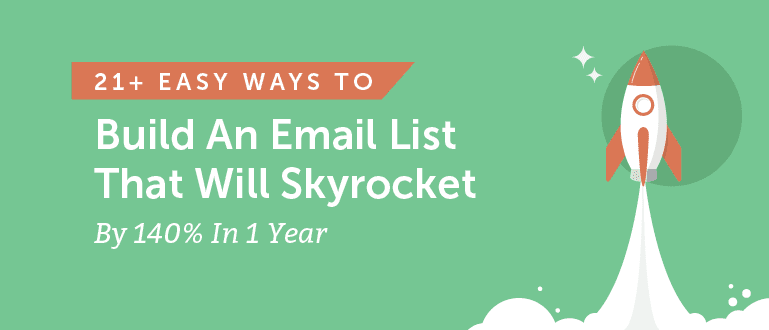 A couple years ago, CoSchedule set a goal to hit 100,000+ subscribers. And wouldn't you know it, we smashed that goal quicker than we could have imagined at the time.
The first goal was to reach 40,000+ subscribers by December 31, 2015, which we did by mid-August 2015. The second goal was to hit 100,000+ subscribers by the end of 2016.
Today in 2018, it's a lot more at over 300,000 subscribers.
That is absolutely bonkers.
Since you likely have the same goals to build an email list of active subscribers who continually read your content, attend your events, and are more likely to convert into paying customers, we thought you'd enjoy using the email list building tactics that have worked for us. Enjoy!
A couple years ago, CoSchedule set a goal to hit 100,000+ subscribers. And wouldn't you know it, we smashed that goal quicker than we could have imagined at the time.
The first goal was to reach 40,000+ subscribers by December 31, 2015, which we did by mid-August 2015. The second goal was to hit 100,000+ subscribers by the end of 2016.
Today in 2018, it's a lot more at over 300,000 subscribers.
That is absolutely bonkers.
Since you likely have the same goals to build an email list of active subscribers who continually read your content, attend your events, and are more likely to convert into paying customers, we thought you'd enjoy using the email list building tactics that have worked for us. Enjoy!
21+ Easy Ways To Build An Email List That Will Skyrocket By 140% In 1 Year
Click To TweetGet Your Free Email List Building Kit ...
You may need a little extra help as you get started with building your email list, so grab these free guides, spreadsheets, templates, and Google Analytics custom reports to rock at email marketing:- Email list building tips template to help beginners get started
- Email list building guide to help you implement every tactic you learn throughout this blog post
- Email subject lines guide to help you increase your open rate
- 500 words to use in your blog titles (and therefore, your email subject lines)
- Email subject line A/B test spreadsheet template to help you continually improve your subject lines
- Best time to send email guide to help you reach the most of your subscribers according to best practices
- Best day to send email Google Analytics custom report to help you use your own data to know the days of the week when your audience opens your email
- Best time to send email Google Analytics custom report to help you send emails at the absolute best times when your audience clicks through to read your content
... And Plan and Schedule Email Marketing With CoSchedule
The best way to schedule email is with a marketing platform built to get your team organized. Now, with its all-new email integrations, CoSchedule is that platform. That isn't hyperbole, either. We believe in eating our own dog food, and use our own product to manage all things marketing across four different internal teams. What exactly can marketing teams accomplish with CoSchedule? Peep these bullets:- Seamlessly integrate with your *favorite* email marketing platform. You already have a kick-a$$ email platform you know and love, so why give it up? With Email Marketing, you can easily connect your preferred email platform to CoSchedule with just a couple clicks.
- Write click-worthy email subject lines...every time. With Email Marketing, you can use CoSchedule’s *exclusive* Email Subject Line Tester to optimize and perfect every subject line to drive more opens, more clicks, and more conversions.
- Get full visibility into your ENTIRE marketing strategy. Say “buh-bye” to disjointed marketing content (and constantly jumping from screen to screen). With Email Marketing, it’s easy to see how your email campaigns relate to the rest of your marketing strategy and quickly make adjustments if necessary.
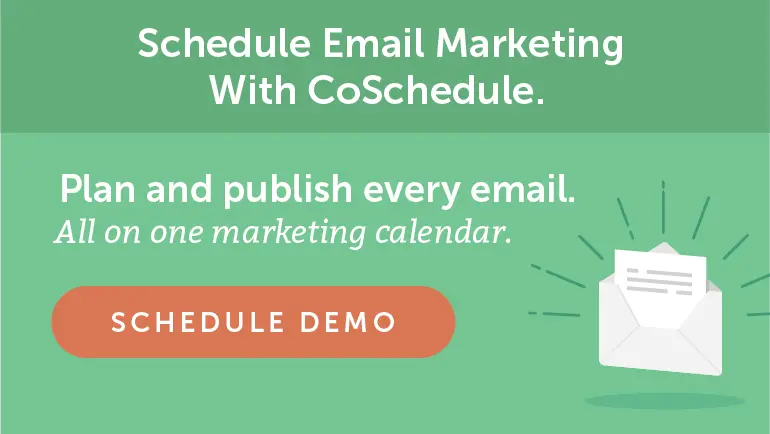 Or, create your free marketing calendar.
Or, create your free marketing calendar.
Market Why Your Readers Should Become Subscribers
1. Never Underestimate A Powerful Call To Action
Bill Jayme, a direct response copywriting genius who is super famous for writing sales letters, used the word free and tons of variations of that word throughout his copy. Free is super effective. As a marketer, you're well aware of selling the benefits of your product to entice prospects to buy. The same rules apply for your marketing: Sell your visitors on why they should subscribe to receive your content. Ultimately, using words like free, become, better, and now in our calls to action helped us gather the majority of the subscribers. Carefully pick the words you use with your limited copy to inspire deep emotion that makes your readers feel like they will miss out if they don't subscribe. For example, Noah Kagan and his crew at SumoMe did this super well with a training course: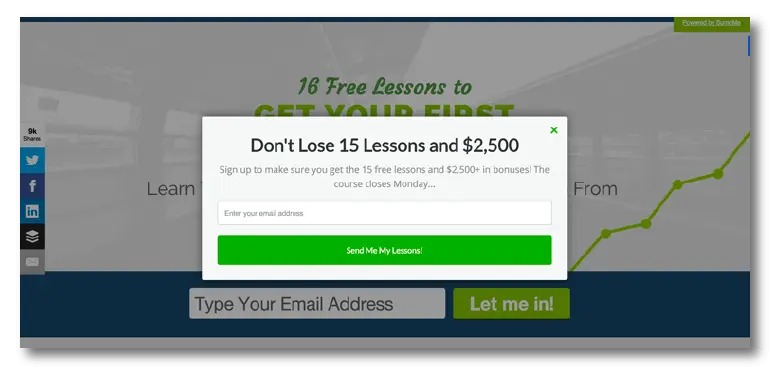 This call to action inspired more than 9,000 social media shares and 5,000+ participants in the group. It reads:
This call to action inspired more than 9,000 social media shares and 5,000+ participants in the group. It reads:
Don't Lose 15 Lessons and $2,500 Sign up to make sure you get the 15 free lessons and $2,500+ in bonuses! The course closes Monday... Send Me My Lessons!This is awesome because Noah's fans think:
- Who likes missing out on lessons limited to only the first few who sign up?
- I hate losing money. I don't even know what value I'm getting, but $2,500 is a lot of cash.
- This stuff is free. I like things I don't have to pay for.
- I only have until Monday to do this, so I better act now before I miss out and be a loser. :(
2. Social Proof Goes A Long Way
"Join Over 100k Blog Subscribers" says a lot about your content in few words. Picture your readers asking themselves: "If 100,000 other people trust these guys to provide awesome content, why shouldn't I?" Ed Hallen found 5 ways of showing social proof that influence credibility:
Ed Hallen found 5 ways of showing social proof that influence credibility:
- Expert: When an authority in your industry says awesome stuff about you. It works because people look up to them and value their opinion as a thought leader. It's the halo effect applied as a psychological marketing trigger.
- Celebrity: Ed mentions the extended self as the reason this works. People search for group membership to mark their position in society, and feeling attached to a celebrity kinda creates this attachment to a product or brand.
- User: Your readers tend to put themselves in the shoes of others. Testimonials, even about your content to help trigger subscribers, can inspire action. Imagine a case study of how your content helped a user do something wonderful! That story would be super powerful.
- Wisdom of the crowds: If tons of people already trust you for awesome content, why shouldn't more? Ed hints that this tactic of showing the masses who subscribe to your content appeals to the fear of missing out. What are your visitors missing who aren't subscribers?
- Wisdom of your friends: This is actual word of mouth, likes on social media, and similar referrals. In one study, referrals were 18% less likely to churn—making this super powerful.
Give Your Readers Something Sweet For Becoming Subscribers
3. Build Tools And Give Them Away Fo' Free
Click To Tweet is a popular tool that more than 15,000 WordPress blogs use to increase the number of social shares for their blog posts. Those who use it love it to add functional visual breaks into their content while increasing their shares and traffic. Win-win-win.Use Click To Tweet to encourage your readers to share your content.
Click To Tweet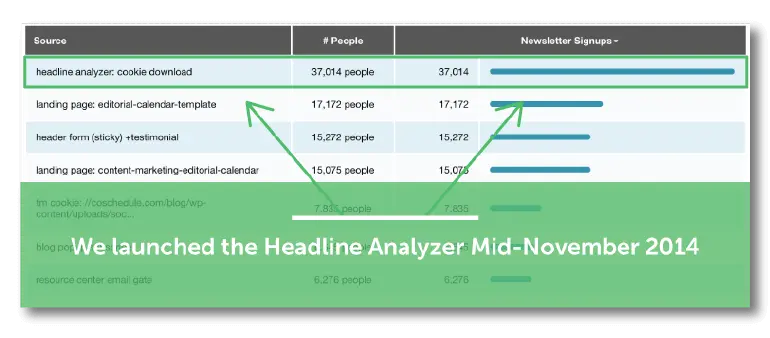 We wrote a blog post to complement the analyzer and offer a free tear sheet of the words you can use to get a better score. Oh, and we made it difficult to pass up on the download:
We wrote a blog post to complement the analyzer and offer a free tear sheet of the words you can use to get a better score. Oh, and we made it difficult to pass up on the download:
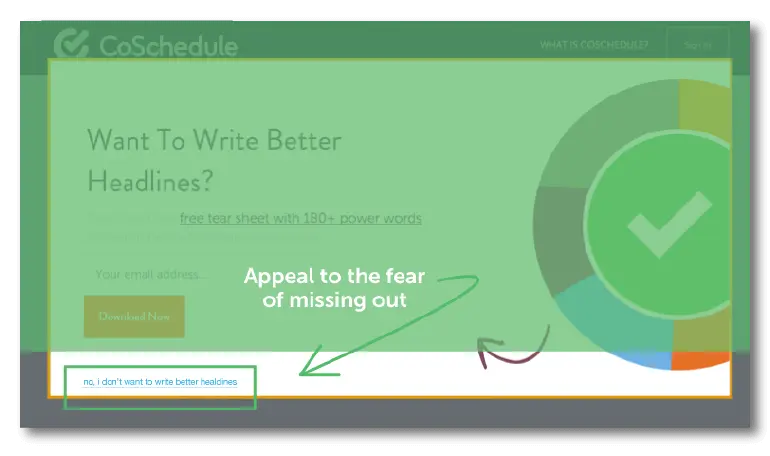
- What super helpful tools could you create? Get a list going and prioritize the ones that are the best opportunity for 10x growth.
- Brainstorm how you could build those tools. If you can't build something in-house, how much are subscribers worth in your budget for marketing? Think of outsourcing development. A tool that took us about two weeks to build provides more subscribers than any of our other content. It could be the same for you.
4. Publish Landing Pages Dedicated To Providing Free Content
Our most popular landing page is dedicated to providing a social media strategy e-book. It's a huge search term for us, and it's awesome because it's a gateway to introducing CoSchedule as the social media calendar that takes what our audience reads in the book to the next level.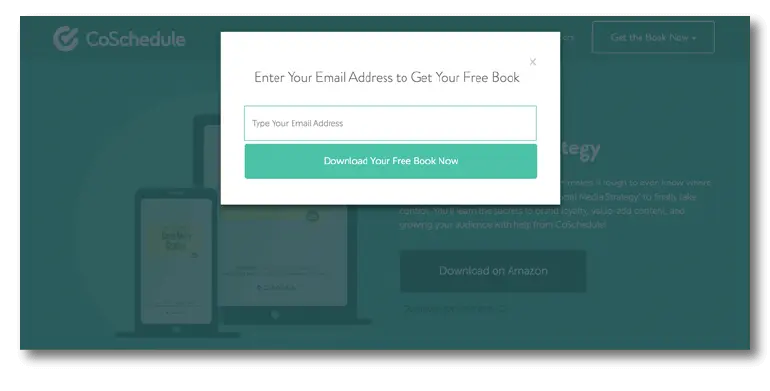 Some of our other super popular landing pages are similar to any other blog post on our site:
Some of our other super popular landing pages are similar to any other blog post on our site:
- They're super actionable with content that goes deep into solving a problem.
- They are long-form.
- They target a keyword our audience is actively searching for.
- Most explain exactly how to use the templates once visitors download them.
5. Give Away Relevant, Contextual Content
We experimented with providing free content to complement every blog post. When we found that people really like templates, guides, worksheets, and checklists that summarize the actionable advice from our super long blog posts, we decided to include downloads in every blog post we publish. Sure, some blog posts are more popular than others, but every one usually gives us at least 250 new subscribers in its first week. Some get as many as 2,000 subscribers when we give away really interesting guides! And because we really hone in our posts to target the keywords our audience searches for, the free content continually gives a few new subscribers every week. Those few add up to a lot over time when you publish two blog posts a week. Folks like Brian Dean at Backlinko and Neil Patel at Quick Sprout do this, too. Brian is super smart, and even includes bonus content in his downloads that you can't get in his posts:
Folks like Brian Dean at Backlinko and Neil Patel at Quick Sprout do this, too. Brian is super smart, and even includes bonus content in his downloads that you can't get in his posts:
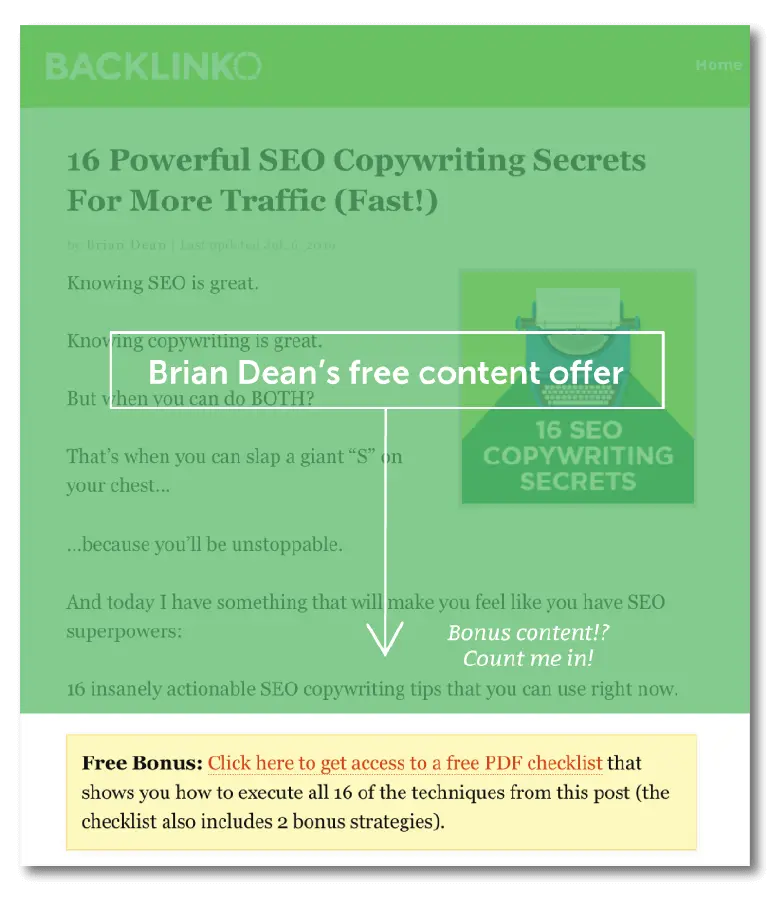 People like to get more for less. Which brings us to our next point...
People like to get more for less. Which brings us to our next point...
6. Take Advice From Your Internet Service Provider On Bundles
"Save a ton of money when you get a landline, Internet, and your cable with us!" Well, I'm not sure how many people really need a landline anymore these days, but the idea is awesome when you apply it to your content. Instead of providing one free piece of awesome content in exchange for an email address, why not two? We asked ourselves that question and put it to the test. If you guys and gals like two, why not 10? 10+? Heck 15? 18? 21? The more bonus content we give away for a single email address, the higher the conversions. The bigger the bundle of giveaways, the more people subscribe. It's an incredible finding that makes total sense in hindsight. We use welcome gifts to provide free content to new folks reading CoSchedule blog posts. For example, when we gave away just one checklist, our average conversion was 3.38%. Not bad, right?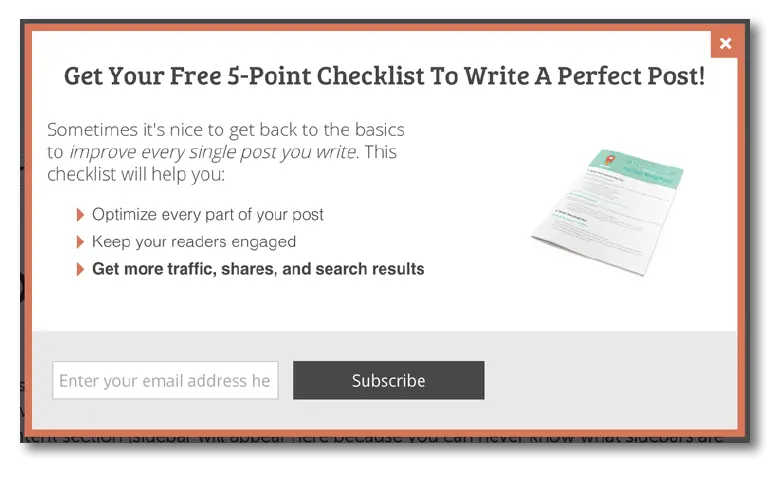 But when we switched to provide content bundles of 15 and scheduled the welcome popup to show up once every five days, conversions jumped to more than 6%.
But when we switched to provide content bundles of 15 and scheduled the welcome popup to show up once every five days, conversions jumped to more than 6%.
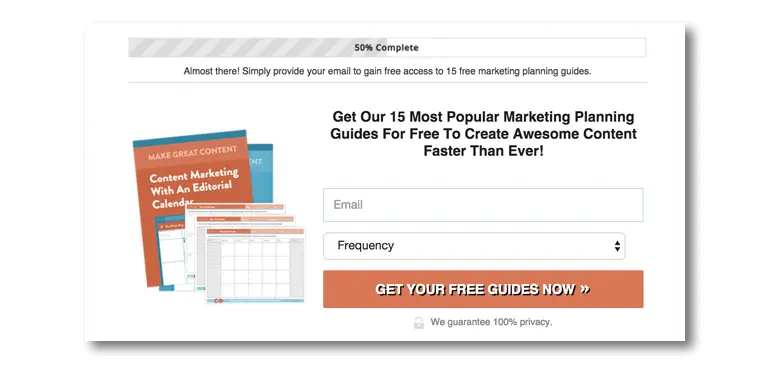 Now we're showing the popup more often—and to more people—and it's converting even higher than our former welcome gift. So, we're getting lots more subscribers by bundling free blog giveaways.
Now we're showing the popup more often—and to more people—and it's converting even higher than our former welcome gift. So, we're getting lots more subscribers by bundling free blog giveaways.

7. Host Webinars And Maximize Your Recordings
We hosted a webinar featuring Evernote: That webinar drew in 566 subscribers to attend the live webinar. Which was pretty awesome. Then we tried hosting a webinar ourselves without a special guest: 111 subscribers signed up for that initially. That's a lot of work for 111 subscribers. So, we learned a few things about webinars that can help you build an email list:- Include a special guest of some notoriety. Remember that thing about experts, celebrities, and social proof? Yeah, it definitely applies here.
- Start promoting earlier rather than later. The more successful of the two webinars had a bit more promotion time. It also helped that we had two companies promoting the webinar: CoSchedule and Evernote. So we were able to tap into a larger audience.
- And if you just tried watching the video replays of the webinars, you'll note that we ask for email addresses after the introductions. That helps us get even more subscribers from the same content. If it was valuable enough to ask for an email address the first time around, your webinar is just as valuable in video format.
8. Explore Email-Automated Courses And Training
We did four email courses back in 2013 to help our then-4-role-big audience. Those were pretty successful considering the size of our audience at the time: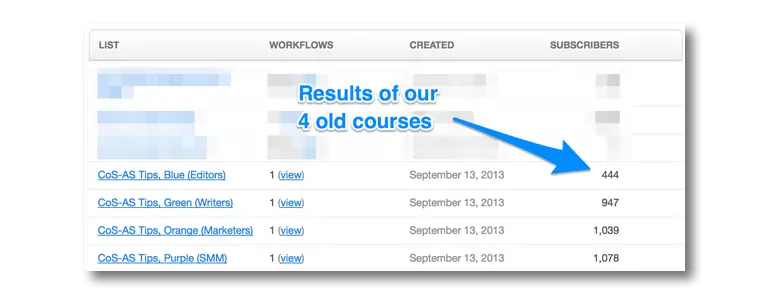 Email courses are a great way to share exclusive content you don't share freely on your blog to entice signups. And we're not the only ones it works for:
Email courses are a great way to share exclusive content you don't share freely on your blog to entice signups. And we're not the only ones it works for:
 Here's a trick from Noah Kagan, too: Find a need, even if it's already been covered a billion times, and create a really awesome tool or template and complement it with helpful advice on how to use it to overcome those challenges. That's a perfect setup for a course.
In their Traffic1M course (growing your traffic to 1 million visits), Noah and Co. made a very nice Google Spreadsheet to help marketers plan goals and tactics to achieve those goals. It was finally a tool to put into action everything marketers know they should do, but may not know how to do it.
The course then runs through how to use the tool as the foundation to grow your traffic. And it's brilliant.
Here's a trick from Noah Kagan, too: Find a need, even if it's already been covered a billion times, and create a really awesome tool or template and complement it with helpful advice on how to use it to overcome those challenges. That's a perfect setup for a course.
In their Traffic1M course (growing your traffic to 1 million visits), Noah and Co. made a very nice Google Spreadsheet to help marketers plan goals and tactics to achieve those goals. It was finally a tool to put into action everything marketers know they should do, but may not know how to do it.
The course then runs through how to use the tool as the foundation to grow your traffic. And it's brilliant.
9. Experiment With Your Giveaways
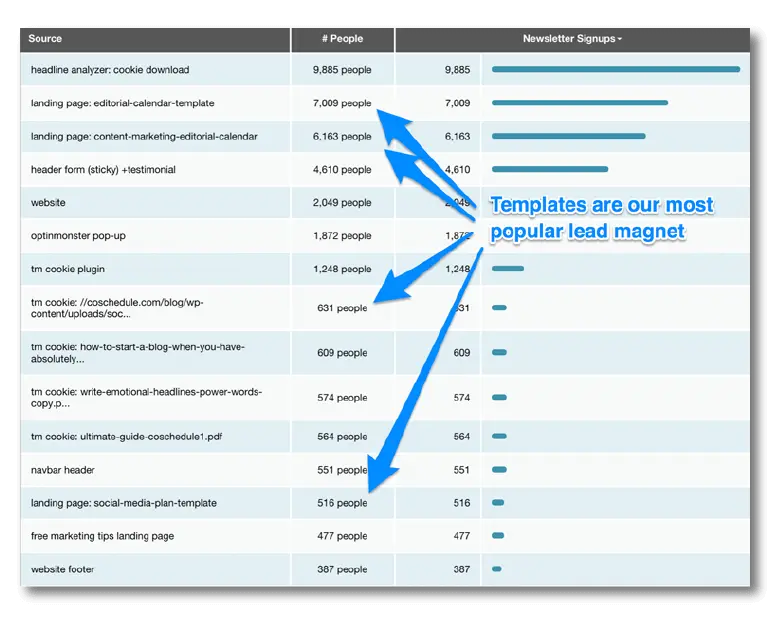 Some content types are just more effective than others. For our audience, we discovered:
Some content types are just more effective than others. For our audience, we discovered:
- Templates are popular. It makes sense since you gals and guys trust us for actionable content, so giving you a tool to put your knowledge into reality is awesome.
- Tear sheets, worksheets, checklists, and guides are also great. This follows the same theory as templates: You just learned something awesome, and these typically provide the big ideas and possibly a few bonus points to help you put what you learned into practice.
- Infographics are alright depending on the topic. When we write about design, graphics, and the like, infographics are super popular.
- E-books have been OK. E-books take a lot of work, yet some of our templates have gotten more downloads.
10. Give Away Something Uniquely Different
As we brainstormed how to reach our second goal of 100k subscribers, we started experimenting with giving away more unique resources in exchange for email addresses. Content upgrades that are immediately usable tend to have extremely high conversion rates. Here are a few examples:- HTML cheat sheet to copy and paste common codes in no time
- Instantly editable spreadsheets that complement every step of a blog post
- Presentation decks to build strategies and share them with your team in a highly visual way
- Photoshop CC action to instantly size any image to perfectly fit every social network
- Word Docs to turn knowledge learned in blog posts into immediate plans
11. Publish Guest Posts On Other Awesome Blogs
One of our most popular downloads is a social media plan template. We published that template on a landing page, launching it specifically to complement a blog post we wrote for the Convince and Convert blog called: 33 Ways Your Social Media Plan Will Make You More Successful. As we wrote the post, we researched the most popular content published on the Convince and Convert blog. 15 minutes of digging around showed us that Convince and Convert readers love long list posts, and any post with the words social media in the headline seemed to perform really well. So we used that knowledge to our advantage, and the very first way to rock a better social media plan was by using a free template from CoSchedule.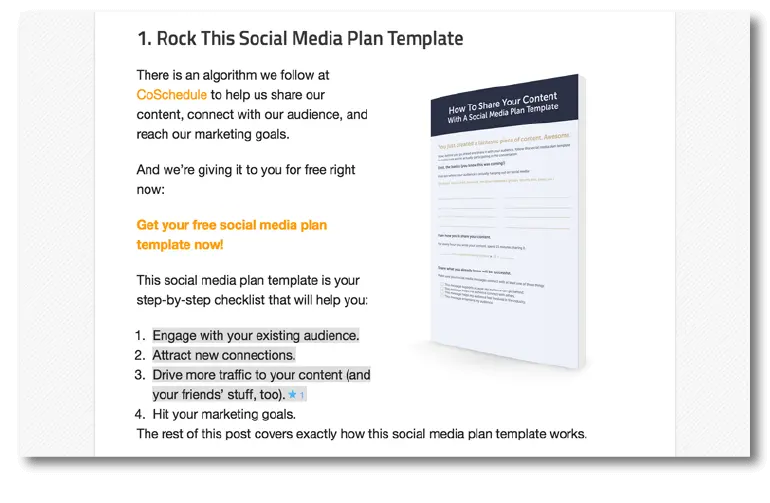 That helped us get 516 subscribers from a single post. Imagine the possibilities when you include guest blogging as a regular part of your content strategy.
Do it yourself:
That helped us get 516 subscribers from a single post. Imagine the possibilities when you include guest blogging as a regular part of your content strategy.
Do it yourself:
- Use tools like the ones from Buzzsumo to research the blogs you'll write guest posts for, or just take a look at the social shares analytics on nearly any blog. Not only will that help you write an awesome pitch (because you can show that you researched the blog and are basing your ideas on what should be super successful for their audience), it will really help you write better content.
- Include a link to a free download specifically related to your guest post using a tool like LeadPages or Unbounce to help turn someone else's audience into your own.
12. Who Said All Of This Needs To Be Digital?
While giving away free content and tools is great because of the instant gratification readers love, we also mix in sending physical care packages to our audience. We give away shirts, stickers, and other cool stuff (even branded water once!) to the vocal folks out there who are just awesome ambassadors for CoSchedule. https://twitter.com/KennyLange/status/586185429914759168 This move is more so a community builder for us rather than an email subscriber generator. But. It's a neat way to connect with our fans and keep them happy, which helps us retain our subscribers and advocates. Plus, it's a feel-good project for everyone!Try These Additional Proven Email List Building Techniques That Work For Noah Kagan
I haven't tried these techniques yet, but they're too good not to share them with you. These are a couple things I'd like to do more of to reach our next subscriber growth goal:13. Ask For Subscribers
Sounds easy, right? It is.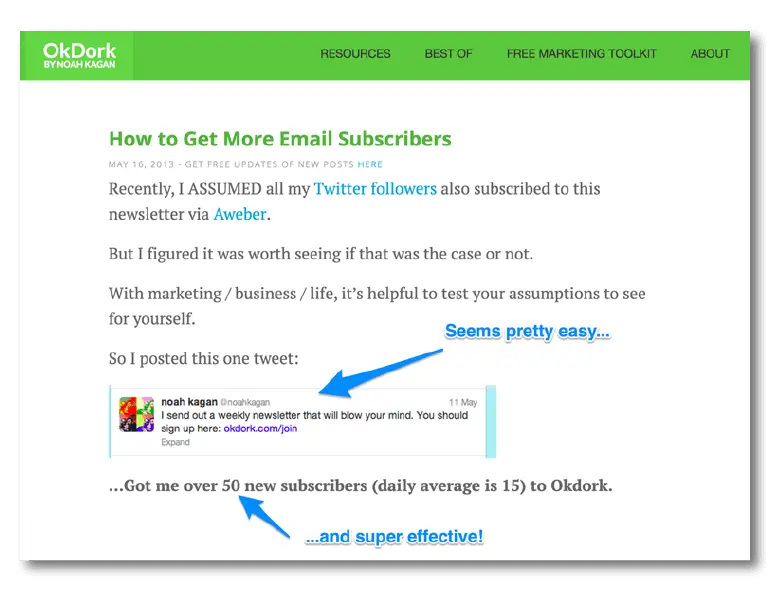 Noah started with Twitter and slowly made his way through his other social networks, simply asking his followers to become subscribers. You can do that, too.
Noah started with Twitter and slowly made his way through his other social networks, simply asking his followers to become subscribers. You can do that, too.
14. Ask Your Subscribers To Forward Info To Their Friends
I signed up for Noah's traffic course to help us optimize the CoSchedule blog for more visitors. When I signed up, there was this brilliant idea: Why not ask your subscribers to share the love with their friends, coworkers, and colleagues? There's probably never a better time for active subscribers than ones who just signed up, so if you see an opportunity like this with your content, I bet it would work.
With more than 5,487 people in that Slack group now, Noah's reach literally doubled because he asked every single person there to inform their friends about the course.
Imagine the possibilities of the "wisdom of your friends" social proof impacting the number of people reached through this tactic. It's brilliant.
Why not ask your subscribers to share the love with their friends, coworkers, and colleagues? There's probably never a better time for active subscribers than ones who just signed up, so if you see an opportunity like this with your content, I bet it would work.
With more than 5,487 people in that Slack group now, Noah's reach literally doubled because he asked every single person there to inform their friends about the course.
Imagine the possibilities of the "wisdom of your friends" social proof impacting the number of people reached through this tactic. It's brilliant.
What Email List Building Tools Actually Work?
Now that you know what kinds of messaging and techniques work, it's time to put it into practice. Here are the tools, tech, and placement we used to build an email list of 100,000+ active subscribers.15. Sticky Navigation
We recently redesigned our blog and opted for a different layout, but this technique was effective for a long time. When you visited our blog and scrolled down a page, you'd see the subscribe bar float at the top of the website. It was a sticky navigation: That sticky navigation brought in a whopping 4,610 subscribers. It works.
This header depends mainly on your WordPress theme with a form directly from your email service provider. We use CampaignMonitor at CoSchedule.
Alternatively, you could try the same approach with tools like Hello Bar, GetSiteControl, Attention Grabber Plugin, or similar ones complemented with a signup form from your email service provider or something like LeadBoxes from LeadPages.
That sticky navigation brought in a whopping 4,610 subscribers. It works.
This header depends mainly on your WordPress theme with a form directly from your email service provider. We use CampaignMonitor at CoSchedule.
Alternatively, you could try the same approach with tools like Hello Bar, GetSiteControl, Attention Grabber Plugin, or similar ones complemented with a signup form from your email service provider or something like LeadBoxes from LeadPages.
16. Sticky Sidebars
Our highest converting Web pages are our blog posts. These have a sticky sidebar that follows visitors down the page with a relevant download that complements the content they're reading (just look to your left now!):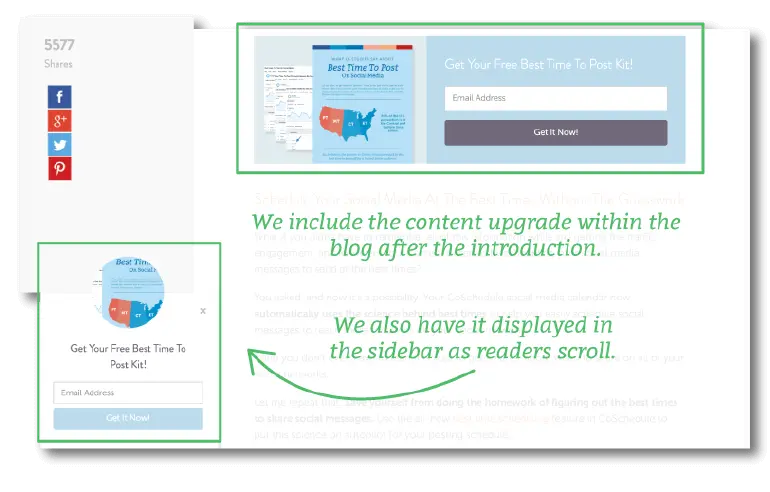 This is a custom plugin we built for our own WordPress blog theme. It's part of the skin of the website, so we just include the download information right in the CMS to show the sidebar.
You can do this, too, by adding something like Hello Bar to your content like Buzzfarmers does:
This is a custom plugin we built for our own WordPress blog theme. It's part of the skin of the website, so we just include the download information right in the CMS to show the sidebar.
You can do this, too, by adding something like Hello Bar to your content like Buzzfarmers does:
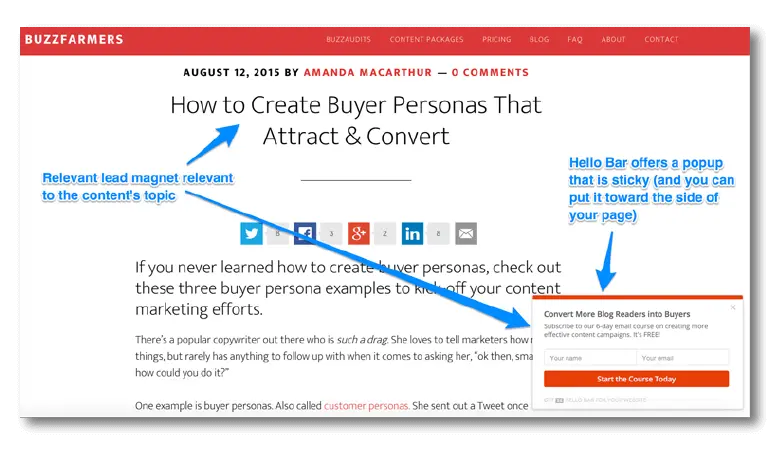
17. Inline Downloads
If you've read a CoSchedule blog post, you've seen an example of an inline download form: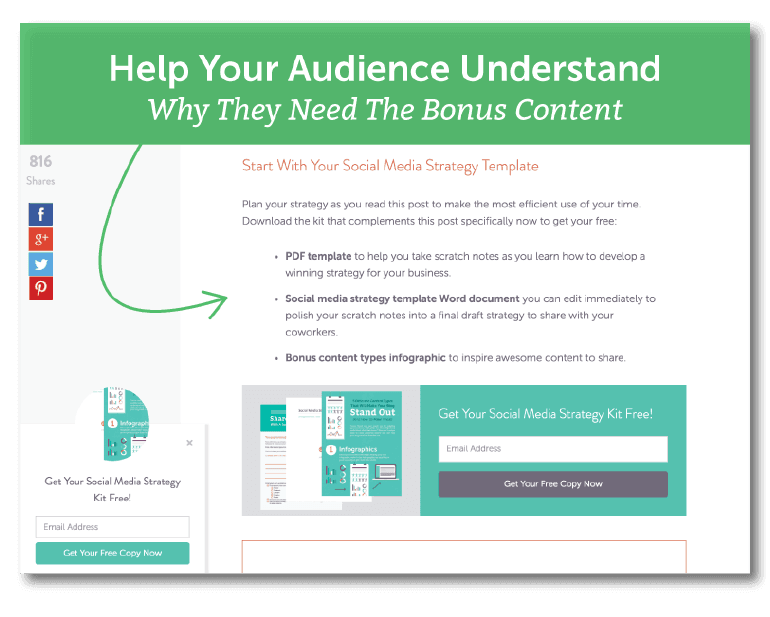 Collectively, these deliver several thousand subscribers every month.
We use a custom-made plugin for our blog, but there are similar tools to help you do this yourself. LeadBoxes from LeadPages is a good alternative for inline downloads:
Collectively, these deliver several thousand subscribers every month.
We use a custom-made plugin for our blog, but there are similar tools to help you do this yourself. LeadBoxes from LeadPages is a good alternative for inline downloads:
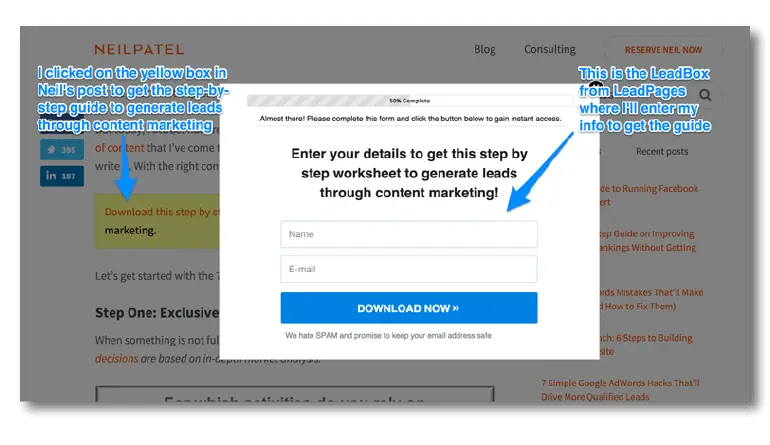
18. Video Embeds
Wistia's Turnstile is awesome for turning video viewers into subscribers: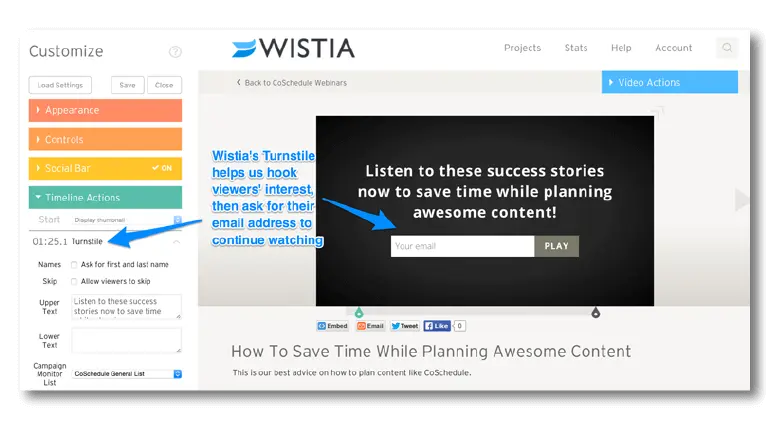
19. Welcome Gifts
We've used OptinMonster and LeadPages to help us welcome new visitors to the CoSchedule blog by giving them a free download or content bundle in exchange for becoming a subscriber. Both were effective lead generators.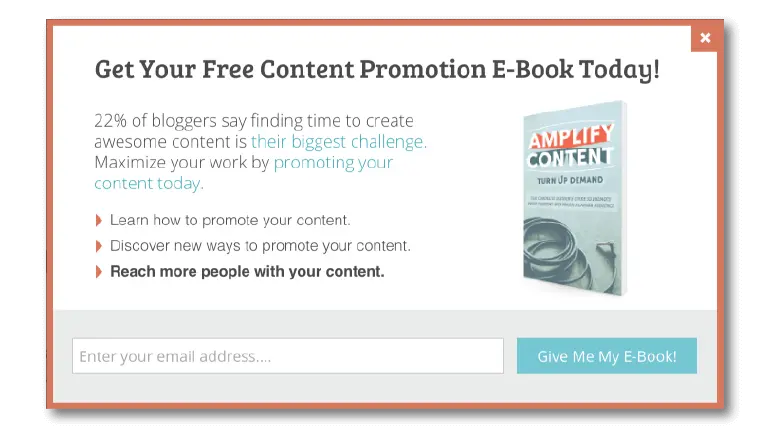 11,328 folks who visited our blog have signed up for welcome gifts.
11,328 folks who visited our blog have signed up for welcome gifts.
20. Exit Intent
What if you could show your visitors one last call to action before they left your site? That's what exit intent is all about.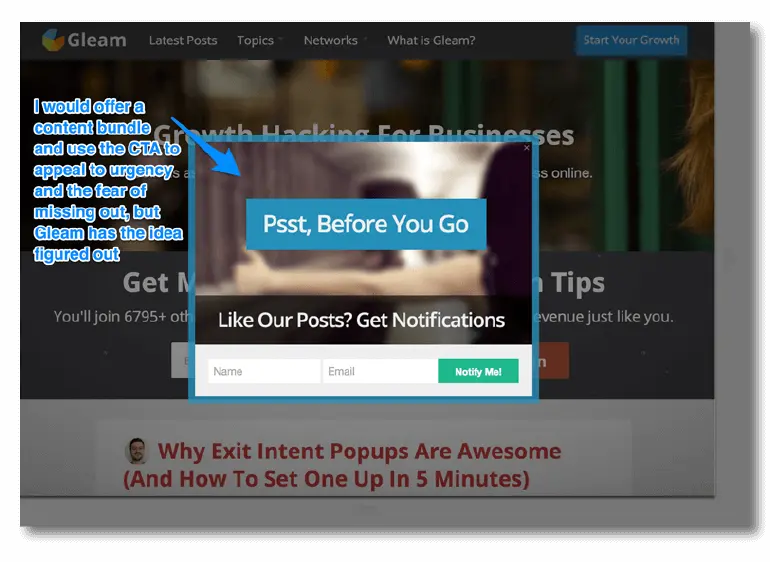 It's a great way to provide one last piece of value to your visitors to convert them into subscribers.
We've used LeadBoxes from LeadPages for exit intent—combined with content bundles. This was effective, but not as much as welcome gifts.
It's a great way to provide one last piece of value to your visitors to convert them into subscribers.
We've used LeadBoxes from LeadPages for exit intent—combined with content bundles. This was effective, but not as much as welcome gifts.
21. Website Footer
The footer of your website is often not the same as your blog. It's a good opportunity to remind folks visiting your business' website to engage with your content to nurture the sale by educating them on the value you have to offer. Expect this to contribute a little more than 1% to your overall growth. Still, it works and is super easy to do: Just embed a signup form from your email service provider right into the footer.
Expect this to contribute a little more than 1% to your overall growth. Still, it works and is super easy to do: Just embed a signup form from your email service provider right into the footer.
22. Measurement
These email list building techniques and tools work for us, but how will you know if they work for you? You've seen tons of screenshots from different tools that help us measure our success:- Kissmetrics is fantastic for helping you understand what is converting. It provides us the data we need to understand the best content types and topics for our audience to convert readers into subscribers.
- Campaign Monitor is the best version of truth for our actual number of subscribers and how many are active. We review our open and clickthrough rates to understand what lead magnets perform better than others.
- Google Analytics is a handy way of understanding which pages are getting traffic so we can compare that to our subscriber conversions.
How Will You Build Your Email List?
Bonus! 22: Check out this video featuring SumoMe, a company that's mastered email list building, to learn even more: Start building your email list today with this handy template. Good luck!How To Build An Email List That Will Skyrocket By 140% To 101,097 In 1 Year
Click To Tweet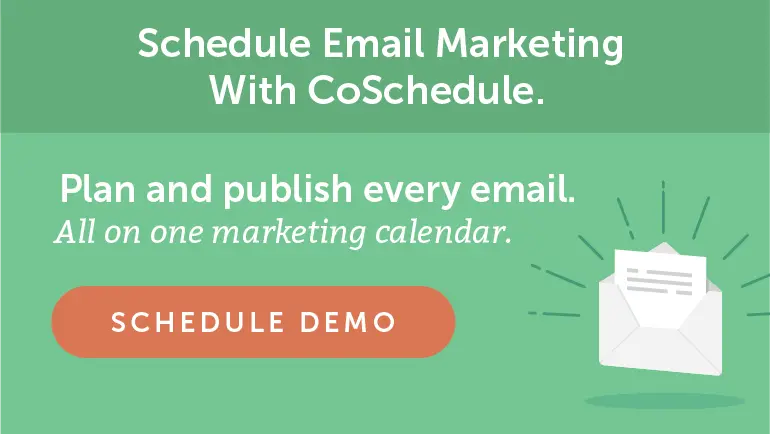 This post was originally published on Aug. 17, 2016. It was republished with new information on May 2, 2018.
This post was originally published on Aug. 17, 2016. It was republished with new information on May 2, 2018.

